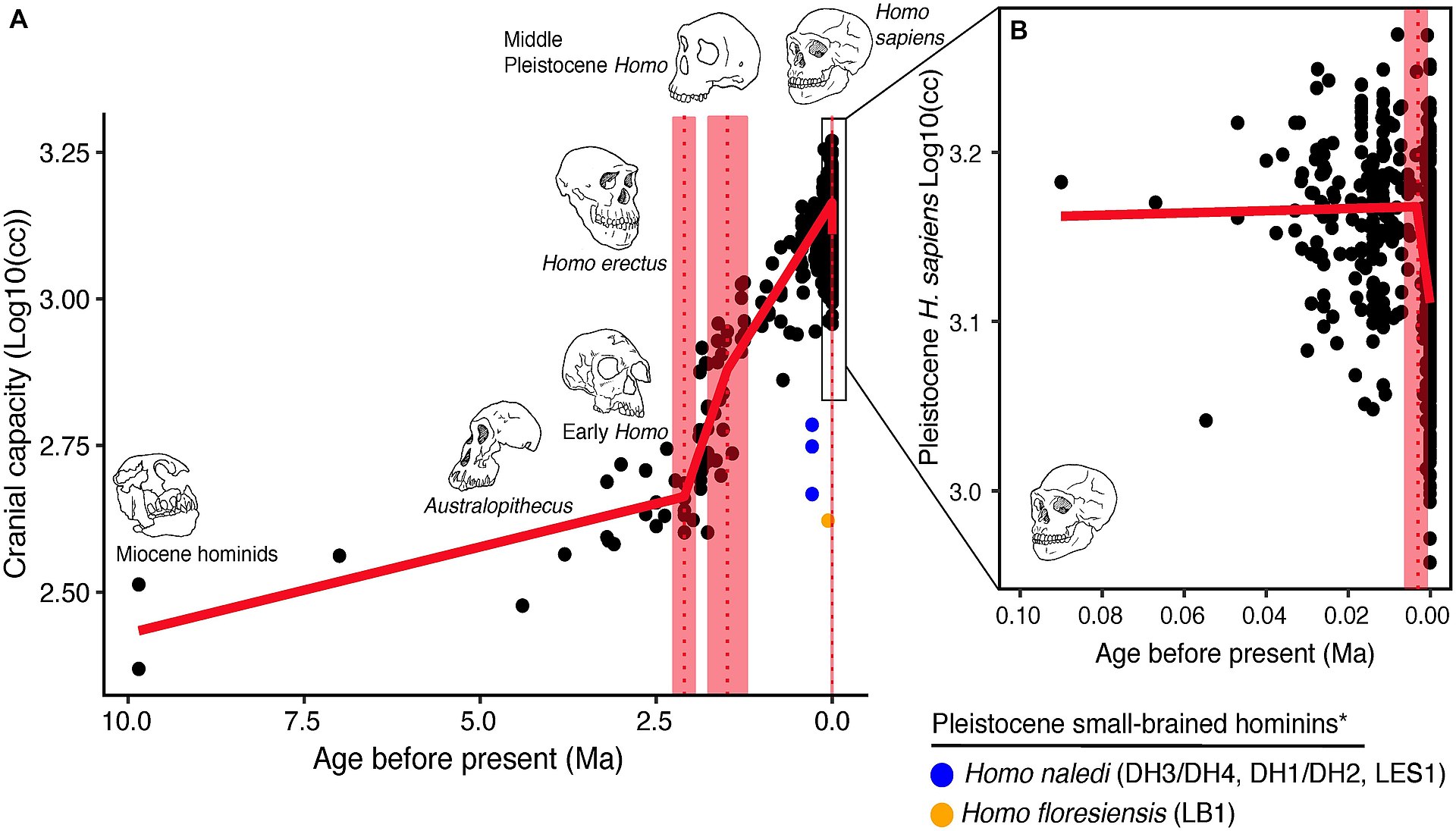
"Trends in hominin brain evolution. (A) Cranial capacity in fossil apes (Miocene hominids) and hominins over the last 10 million years. Brain size remained relatively steady throughout the late Miocene and Pliocene, increasing only slightly in Australopithecus compared with earlier hominins. However, by 2 million years ago, there was a dramatic increase in the rate of growth, coinciding with fossil evidence for the earliest members of genus Homo. This change point is illustrated by a red vertical dotted line (95% CI shown as thick pink vertical line). A second change-point is detected at
~1.5 million years ago and the rate of brain size increase remains steady through the Pleistocene and the evolution of Homo sapiens. If the small-brained Middle and Late Pleistocene hominins H. naledi (blue dots) and H. floresiensis (orange dot) are included, these two change points merge into a single, overlapping encephalization event between 1.97 and 2.21 million years ago. (B) During the last 100,000 years, brain size has remained steady in H. sapiens until a rapid and dramatic change point only 3,000 years ago decreased Holocene human brain size at a rate fifty times greater than the previous increases in Pleistocene brain volume. Each black dot represents an individual fossil skull or osteological specimen."
New age life has made us aware of the technology use in our day-to-day lives. Gadgets such as computers, tablets, and smartphones have become the most integral part of our life. When we think about replacing these gadgets, we first consider the memory of that particular device. Let us understand the phrases “megabytes” and “gigabytes”, which will help us know the storage capacity we look for when we buy any new gadget. The human brain memory is indeed a genius thing that we are gifted with. Human Brain Memory is far away from the imagination of humans. The human brain and nervous system are inclined to problems as any other part of our bodies.
WHAT IS THE MEMORY CAPACITY OF A HUMAN BRAIN?
The human brain is an intricate organ that manages memory, emotion, thoughts, touch, vision, breathing patterns, and every procedure that controls the human body. The brain, accompanied by the spinal cord, forms the nervous system. The experts calculated the human brain storage by gauging connections between brain cells and decoded that number into bytes and computer memory units.
The human brain contains billions of neurons, each forming thousands of connections. A single byte comprises 8 bits, and the human brain can store more than one quadrillion bytes of data – a petabyte. As mentioned in an article in Scientific American, the memory capacity of a human brain was testified to have equal to 2.5 petabytes of memory capacity. A “petabyte” means 1024 terabytes or a million gigabytes so that the average adult human brain can accumulate the equivalent of 2.5 million gigabytes of memory. As per the reports of the study conducted by Stanford, the human brain compares constructively with the most authoritative modern computers.
The cerebral cortex in the human brain is proficient in possessing 125 trillion synapses, which may stock as much as 2.5 petabytes of overall memory capacity.
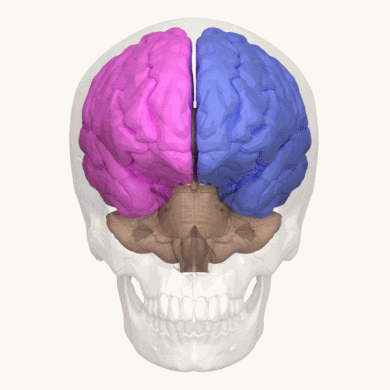
CATEGORIES OF MEMORY
Memory is classified into 3 broad categories. These include-
- Sensory memory: It allows you to remember sensory information after the stimulus has ended. Other memories begin after the formation of sensory memories. When the sensory experience keeps recurring, it might move to long term memory.
- Short term memory: It allows you to recall short term information for a brief period. Research estimates that short term memory lasts about 30 seconds. You can keep information in short term memory by rehearsing it. For example, string of numbers.
- Long term memory: We story a vast majority of our memories in long term memory. Any memory we can recall after 30 seconds is long term memory. There is no limit to how much our long term memory can hold and for how long. It has 2 main categories, explicit and implicit.
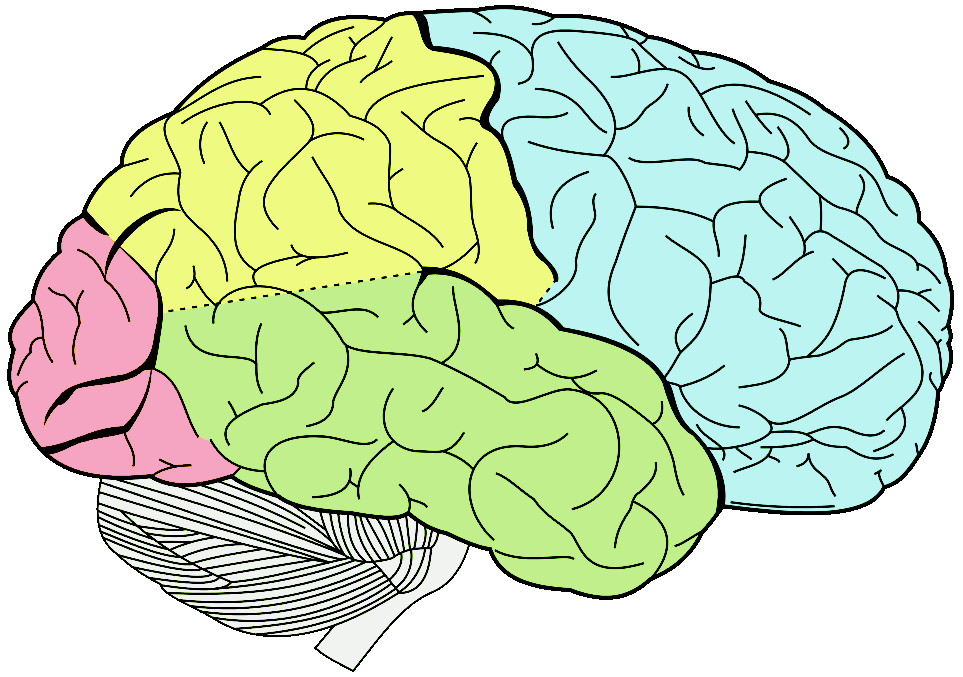
The human brain consists of about one billion neurons. Each neuron forms about 1,000 connections to other neurons, amounting to more than a trillion connections. If each neuron could only help store a single memory, running out of space would be a problem. You might have only a few gigabytes of storage space, similar to the space in an iPod or a USB flash drive. Yet neurons combine so that each one helps with many memories at a time, exponentially increasing the brain’s memory storage capacity to something closer to around 2.5 petabytes (or a million gigabytes). For comparison, if your brain worked like a digital video recorder in a television, 2.5 petabytes would be enough to hold three million hours of TV shows. You would have to leave the TV running continuously for more than 300 years to use up all that storage.
HOW BIG IS A HUMAN BRAIN?
The human brain weighs about three pounds and has a volume of about 1,300 cubic centimeters, (with a skull capacity of around 1,600cc), about the size of ten tennis balls. Humans have some of the largest brains compared to other animals. This is especially true if you consider the size of the brain relative to the size of the body. In humans, the brain makes up about two percent of our body mass.
Let’s consider how that number compares with other mammals. At 400 cubic centimeters, which is about the size of three tennis balls, the brain of
chimpanzees - our closest living relatives - is only 0.8 percent of their body mass. An elephant’s brain, although measuring a whopping 7,200 cubic centimeters, is only 0.1 percent of its mass. Now you can begin to see that human brain size is actually quite impressive.
WHY DID HUMANS EVOLVE SUCH LARGE BRAINS
Brains require a lot of energy to grow and maintain. This makes them an expensive organ. There had to be an advantage to having a large brain in order for brain size to increase during human evolution. Think about what benefits may be related to having a large brain. For humans, a larger brain means greater intelligence. Our intelligence allows us to process and store information. It also allowed language to evolve.
Humans depend on language, social learning, and culture. Imagine living in a society without language or strong social bonds. Sounds pretty lonely. Language made it easier and quicker to learn and to communicate with one another. It also made social bonds between family members and friends stronger. Having a larger brain may have let our ancestors develop a complex culture.
GENDER, GROWTH RATE AND SHRINKING
A human baby's brain at birth averages 369 cm3 and increases, during the first year of life, to about 961 cm3, after which the growth rate declines. Brain volume peaks at the teenage years, and after the age of 40 it begins declining at 5% per decade, speeding up around 70. Average adult male brain weight is 1,345 grams (47.4 oz), while an adult female has an average brain weight of 1,222 grams (43.1 oz). (This does not take into account neuron density nor brain-to-body mass ratio; men on average also have larger bodies than women.) Males have been found to have on average greater cerebral, cerebellar and cerebral cortical lobar volumes, except possibly left parietal. The gender differences in size vary by more specific brain regions. Studies have tended to indicate that men have a relatively larger amygdala and hypothalamus, while women have a relatively larger caudate and hippocampi. When covaried for intracranial volume, height, and weight, Kelly (2007) indicates women have a higher percentage of gray matter, whereas men have a higher percentage of white matter and cerebrospinal fluid. There is high variability between individuals in these studies, however.

KANIS
REX
Man
took millions of years to develop from the apes, into
Homo Sapiens Sapiens, king of the primates. Then John
Storm was accidentally injected with a CRISPR
virus developed by Brazilian scientists working for the secret society; NeuWelt
Rittertum. The amateur anthropologist was later forced to
undo damaging alterations to his DNA, in so doing turning himself into a new
species, physically and mentally superior to Homo S. Sapiens; named Homo
Sapiens Superior, or Kanis
Rex. These modifications were sufficient in scope to place him well
and truly in a new class. Progressing from Homo Sapiens Sapiens, to
become the king of men genetically speaking. As eventually demonstrated
and agreed by 12 eminent scientists at a Round Table meeting with George
Franks.
The
genetic modifications to John
Storm, were only possible with the CyberCore Genetica™
super
computer, combined with the BioCore™
brain implant, working in tandem with the Elizabeth
Swann's
AI,
Hal.
The genome upgrades were not just to mental and muscular capabilities, but also to his
physical frame; John's skeleton, (brain) and skull. Which is now stronger,
lighter with increased neuron capacity. All of
which in the natural world, would have taken a million or so years to
have achieved, via natural selection advantage.
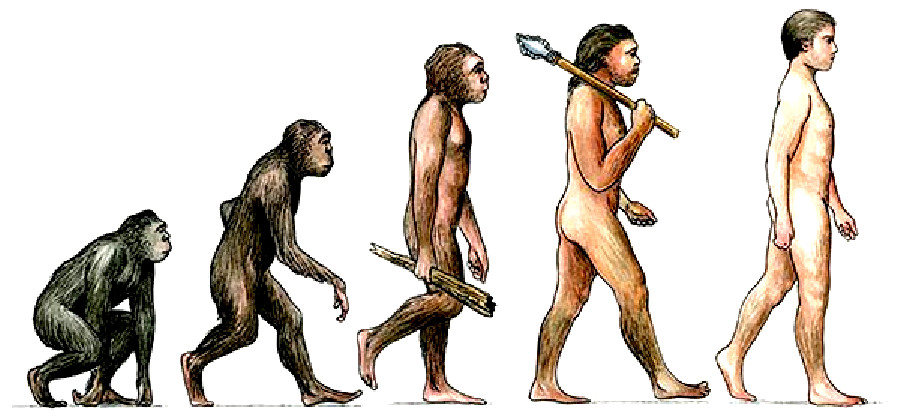
BRAIN
SIZE RELATIVE TO INTELLIGENCE
Studies demonstrate a correlation between brain size and intelligence, larger brains predicting higher intelligence. It is however not clear if the correlation is causal. The majority of MRI studies report moderate correlations around 0.3 to 0.4 between brain volume and intelligence. The most consistent associations are observed within the frontal, temporal, and parietal lobes, the hippocampus, and the cerebellum, but only account for a relatively small amount of variance in IQ, which suggests that while brain size may be related to human intelligence, other factors also play a role. In addition, brain volumes do not correlate strongly with other and more specific cognitive measures. In men, IQ correlates more with gray matter volume in the frontal lobe and parietal lobe, which is roughly involved in sensory integration and attention, whereas in women it correlates with gray matter volume in the frontal lobe and Broca's area, which is involved in language.
Research measuring brain volume, P300 auditory evoked potentials, and intelligence shows a dissociation, such that both brain volume and speed of P300 correlate with measured aspects of intelligence, but not with each other. Evidence conflicts on the question of whether brain size variation also predicts intelligence between siblings, as some studies find moderate correlations and others find none. A
review by Nesbitt, Flynn et al. (2012) point out that crude brain size is unlikely to be a good measure of IQ, for example brain size also differs between men and women, but without well documented differences in IQ.
A discovery in recent years is that the structure of the adult human brain changes when a new cognitive or motor skill, including vocabulary, is learned. Structural neuroplasticity (increased gray matter volume) has been demonstrated in adults after three months of training in a visual-motor skill, as the qualitative change (i.e. learning of a new task) appear more critical for the brain to change its structure than continued training of an already-learned task. Such changes (e.g. revising for medical exams) have been shown to last for at least 3 months without further practicing; other examples include learning novel speech sounds, musical ability, navigation skills and learning to read mirror-reflected words.
COMPARED WITH OTHER ANIMALS
The largest brains are those of sperm
whales, weighing about 8 kg (18 lb). An elephant's brain weighs just over 5 kg (11 lb), a bottlenose
dolphin's 1.5 to 1.7 kg (3.3 to 3.7 lb), whereas a human brain is around 1.3 to 1.5 kg (2.9 to 3.3 lb). Brain size tends to vary according to body size. The relationship is not proportional, though: the brain-to-body mass ratio varies. The largest ratio found is in the shrew.
Primates, for a given body size, have brains 5 to 10 times as large as the formula predicts. Predators tend to have relatively larger brains than the animals they prey on; placental mammals (the great majority) have relatively larger brains than marsupials such as the opossum. A standard measure for assessing an animal's brain size compared to what would be expected from its body size is known as the encephalization quotient. The encephalization quotient for humans is between 7.4-7.8.
The evolution of Homo sapiens over the past two million years has been marked by a steady increase in brain size, but much of it can be accounted for by corresponding increases in body size. There are, however, many departures from the trend that are difficult to explain in a systematic way: in particular, the appearance of modern man about 100,000 years ago was marked by a decrease in body size at the same time as an increase in brain size. Even so, it is noteworthy that Neanderthals, which became extinct about 40,000 years ago, had larger brains than modern Homo sapiens.
CRANIAL CAPACITY
Cranial capacity is a measure of the volume of the interior of the skull of those vertebrates who have a brain. The most commonly used unit of measure is the cubic centimetre (cm3). The volume of the cranium is used as a rough indicator of the size of the brain, and this in turn is used as a rough indicator of the potential intelligence of the organism. Cranial capacity is often tested by filling the cranial cavity with glass beads and measuring their volume, or by CT scan imaging. A more accurate way of measuring cranial capacity, is to make an endocranial cast and measure the amount of water the cast displaces. In the past there have been dozens of studies done to estimate cranial capacity on skulls. Most of these studies have been done on dry skull using linear dimensions, packing methods or occasionally radiological methods.
Knowledge of the volume of the cranial cavity can be important information for the study of different populations with various differences like geographical, racial, or ethnic origin. Other things can also affect cranial capacity such as nutrition. It is also used to study correlating between cranial capacity with other cranial measurements and in comparing skulls from different beings. Cranial capacity is an indirect approach to test the size of the brain.
However, larger cranial capacity is not always indicative of a more intelligent organism, since larger capacities are required for controlling a larger body, or in many cases are an adaptive feature for life in a colder environment. For instance, among modern Homo sapiens, northern populations have a 20% larger visual cortex than those in the southern latitude populations, and this potentially explains the population differences in human brain size (and roughly cranial capacity). Neurological functions are determined more by the organization of the brain rather than the volume. Individual variability is also important when considering cranial capacity, for example the average Neanderthal cranial capacity for females was 1300 cm3 and 1600 cm3 for males. Neanderthals had larger eyes and bodies relative to their height, thus a disproportionately large area of their brain was dedicated to somatic and visual processing, functions not normally associated with intelligence. When these areas were adjusted to match anatomically modern human proportions it was found Neanderthals had brains 15-22% smaller than in anatomically-modern humans. When the neanderthal version of the NOVA1 gene is inserted into stem cells it creates neurons with fewer synapses than stem cells containing the human version.
Parts of a cranium found in China in the 1970s show that the young man had a cranial capacity of around 1700 cm3 at least 160,000 years ago. This is greater than the average of modern humans.
EXAMPLES OF CRANIAL CAPACITY
Apes
Orangutans: 275–500 cm3 (16.8–30.5 cu in)
Chimpanzees: 275–500 cm3 (16.8–30.5 cu in)
Gorillas: 340–752 cm3 (20.7–45.9 cu in)
Hominids
Anatomically-modern human: average 1473 cm3
Neanderthals: 1500-|1740 cm3
Xujiayao 6 (160 to 200 ka ago): ca. 1700 cm3
Homo erectus; 850 – 1100 cm3
Australopithecus anamensis; 365–370 cm3
Australopithecus afarensis; 438 cm3
Australopithecus africanus 452 cm3
Paranthropus boisei 521 cm3
Paranthropus robustus 530 cm3
BRAIN INJURY AND REDUCED COGNITIVE FUNCTION
Although brain injury from a car accident or a collision during a football game often seems to cause a sudden change to cognitive ability years later, this change does not just appear out of the
blue - the damage has been building up slowly, unnoticed, over time.
Post injury, the progressive brain deterioration that may occur likely reaches a tipping point, after which the loss of function “suddenly” becomes obvious. Depending on the type and severity of the Traumatic Brain Injury (TBI), it can accelerate memory loss or increase a person’s chance of succumbing to Alzheimer’s disease.
TBI commonly damages nerve fibers in the brain called axons. These thin,
tube-like structures transmit electrical and chemical signals that are vital for carrying information among different regions of the brain. For unknown reasons, these fragile structures not only disconnect shortly after injury but can continue to disconnect even for decades later in some patients. Once disconnected, the blunt end of an axon seals itself off, swells with fluids, enzymes and proteins and eventually bursts. When axons burst open, they often distribute amyloid proteins through the neighboring brain tissue. hese sticky proteins are a hallmark of Alzheimer’s, and in fact many TBI patients exhibit signs of dementia later in life that mimic the deterioration observed in Alzheimer’s patients.
In addition, with axons disappearing or not functioning well after TBI, a person’s ability to process new information may slow down. Surviving axons may compensate for the damage by increasing electrical signaling and thus restoring the normal speed of information processing in the brain. This temporary fix, however, can cause these axons to become even more sensitive to damage if a second concussion occurs.
Most people with TBI will have progressive axonal damage, but it is difficult to predict who will suffer from cognitive changes years later. TBIs have a devastating effect on society, with more than 1.5 million cases documented in the U.S. every year. Currently no therapies exist for either short- or long-term damage, which means for now the best treatment is protection and prevention.
Sahelanthropus
Ardipithecus
Australopithecus
A. anamensis
A. afarensis
A. bahrelghazali
A. africanus
A. garhi
A. sediba
Kenyanthropus
Paranthropus robustus
Homo habilis
H. floresiensis
H. erectus
H. e. georgicus
H. cepranensis
H. antecessor
H. heidelbergensis
H. naledi
H. helmei
H. neanderthalensis
Homo sapiens
H. s. idaltu
H. s. sapiens - Brain
capacity
Homo
Sapiens Superior (Kanis
Rex)
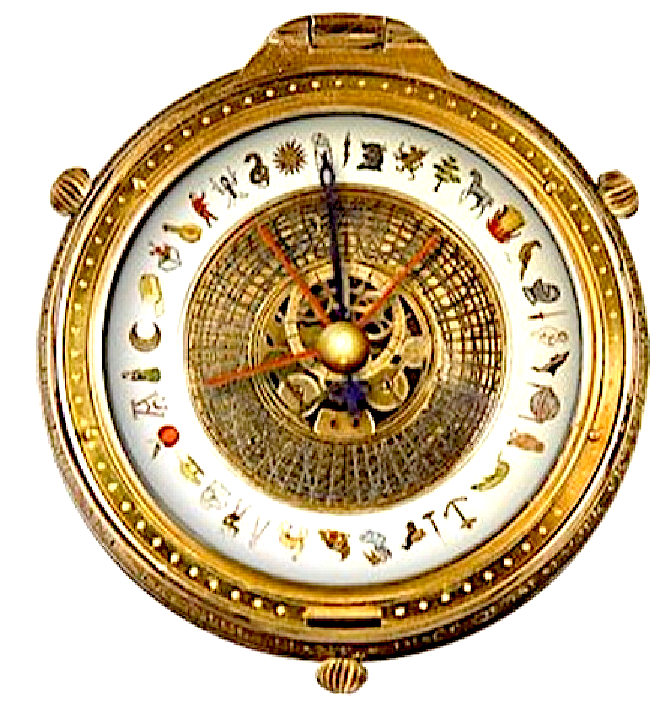
EVOLUTION
Humans are apes (superfamily Hominoidea). The lineage of apes that eventually gave rise to humans first split from gibbons (family Hylobatidae) and orangutans (genus Pongo), then gorillas (genus Gorilla), and finally, chimpanzees and bonobos (genus Pan). The last split, between the human and
chimpanzee - bonobo lineages, took place around 8 - 4 million years ago, in the late Miocene epoch. During this split, chromosome 2 was formed from the joining of two other chromosomes, leaving humans with only 23 pairs of chromosomes, compared to 24 for the other apes. Following their split with chimpanzees and bonobos, the hominins diversified into many species and at least two distinct genera. All but one of these
lineages - representing the genus Homo and its sole extant species Homo
sapiens - are now extinct.
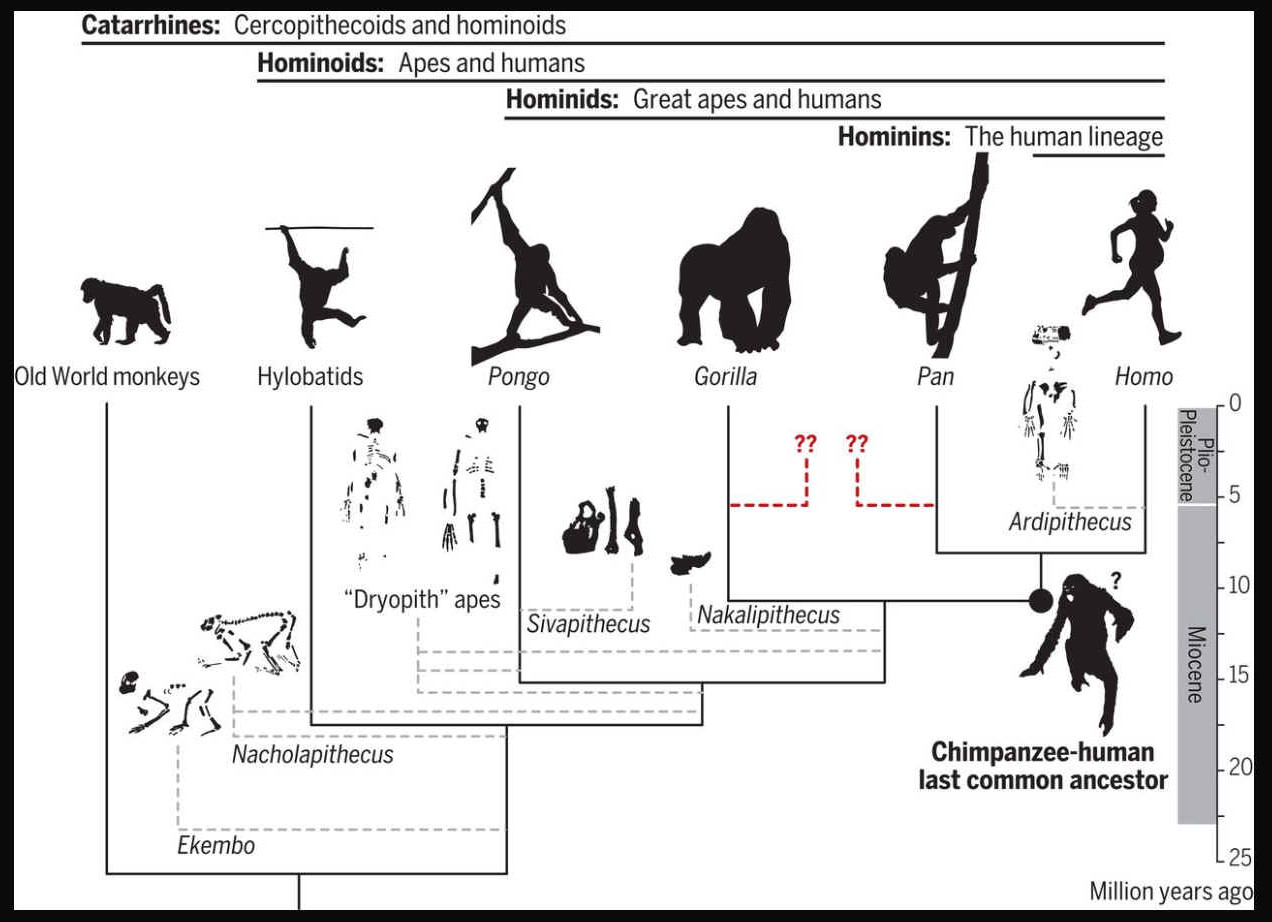
How
we got here, and where we are going. Ever since the writings of Darwin and Huxley,
humans’ place in nature relative to apes (nonhuman hominoids) and the geographic origins of the human lineage (hominins) have been heavily debated. Humans diverged from apes [specifically, the chimpanzee lineage (Pan)] at some point between ~9.3 million and ~6.5 million years ago (Ma), and habitual bipedalism evolved early in hominins (accompanied by enhanced manipulation and, later on, cognition). To understand the selective pressures surrounding hominin origins, it is necessary to reconstruct the morphology, behavior, and environment of the Pan-Homo last common ancestor (LCA). “Top-down” approaches have relied on living apes (especially chimpanzees) to reconstruct hominin origins. However, “bottom-up” perspectives from the fossil record suggest that modern hominoids represent a decimated and biased sample of a larger ancient radiation and present alternative possibilities for the morphology and geography of the Pan-Homo LCA. Reconciling these two views remains at the core of the human origins problem.
The genus Homo evolved from Australopithecus. Though fossils from the transition are scarce, the earliest members of Homo share several key traits with Australopithecus. The earliest record of Homo is the 2.8 million-year-old specimen LD 350-1 from Ethiopia, and the earliest named species are Homo habilis and Homo rudolfensis which evolved by 2.3 million years ago. H. erectus (the African variant is sometimes called H. ergaster) evolved 2 million years ago and was the first archaic human species to leave Africa and disperse across Eurasia. H. erectus also was the first to evolve a characteristically human body plan. Homo sapiens emerged in Africa around 300,000 years ago from a species commonly designated as either H. heidelbergensis or H. rhodesiensis, the descendants of H. erectus that remained in Africa. H. sapiens migrated out of the continent, gradually replacing or interbreeding with local populations of archaic humans.
Humans began exhibiting behavioral modernity about 160,000-70,000 years ago, and possibly earlier.
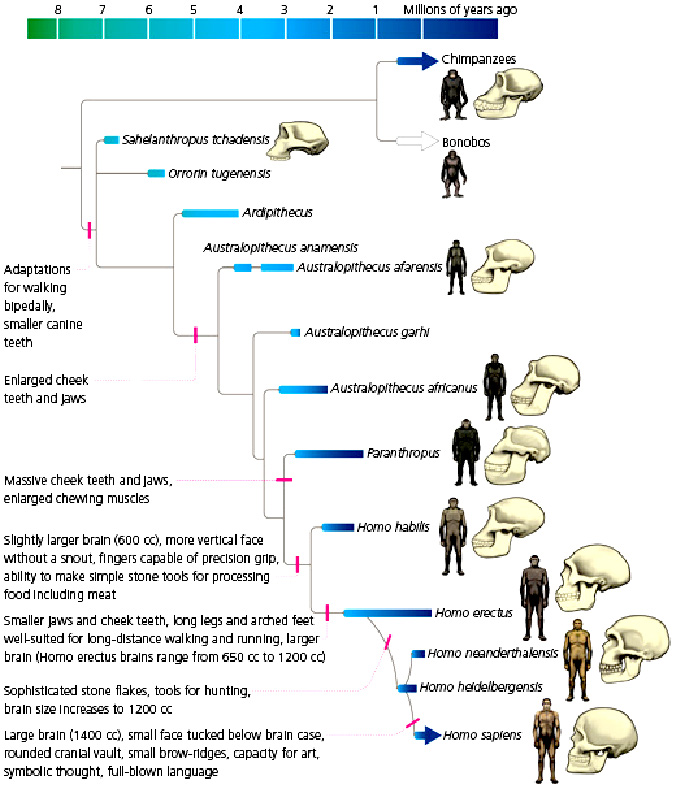
The "out of Africa" migration took place in at least two waves, the first around 130,000 to 100,000 years ago, the second (Southern Dispersal) around 70,000 to 50,000 years ago. H. sapiens proceeded to colonize all the continents and larger islands, arriving in Eurasia 125,000 years ago, Australia around 65,000 years ago, the Americas around 15,000 years ago, and remote islands such as Hawaii, Easter Island, Madagascar, and New Zealand between the years 300 and 1280 CE.
Human evolution was not a simple linear or branched progression but involved interbreeding between related species. Genomic research has shown that hybridization between substantially diverged lineages was common in human evolution. DNA evidence suggests that several genes of Neanderthal origin are present among all non sub-Saharan African populations, and Neanderthals and other hominins, such as Denisovans, may have contributed up to 6% of their genome to present-day non sub-Saharan African humans.
Human evolution is characterized by a number of morphological, developmental, physiological, and behavioral changes that have taken place since the split between the last common ancestor of humans and chimpanzees. The most significant of these adaptations are obligate bipedalism, increased brain size and decreased sexual dimorphism (neoteny). The relationship between all these changes is the subject of ongoing debate.

The
Cup of Christ is the Holy Grail, that has never been found, in all
searches through the ages.







